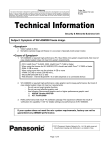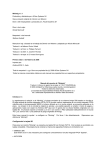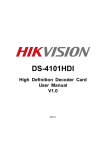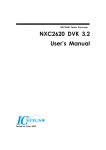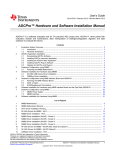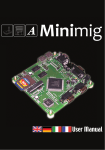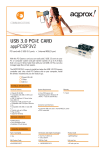Download Sam460ex User Guide
Transcript
Sam460ex User Guide version 1.3 – 08 December 2012 ACube Systems S.r.l. Via Tabacco, 58 - 36061 Bassano del Grappa, (Vi) – Italy Tel. +39 0424 393120 fax +39 0424 393119 www.acube-systems.biz - www.sam4x0.com [email protected] VAT ID 03367150244 –REA VI-319762 Introduction Your Sam460ex board is ready to go. Just connect a hard drive, monitor, mouse and keyboard, and switch it on! It can be housed into a flex-ATX, micro-ATX or full ATX computer case. The use of a good quality ATX power supply is strongly advised for a correct operation of the board. Sam460ex Hardware Specifications flex-ATX form factor (21.6 x 17 cm) 8 layers PCB AMCC 460ex SoC – upto 1.150 Ghz max 2 GB DDR2 Ram – 200-pin SODIMM Silicon Motion SM502 embedded MoC (audio/video) max 64MB Gfx RAM Audio 5.1 Realtek ALC655 codec PCI-express 4x lanes slot (16x mechanical connector) PCI-express 1x lane slot (* check notes) PCI slot, 32 bits, 33/66 Mhz, 3.3V 1x SATA2 port (* check notes) 6x USB2 EHCI/OHCI ports + 1 USB1.1 port 1x 10/100/1000 Ethernet port (another 10/100/1000 Ethernet port is optional) Lattice XP2 FPGA with 80 I/O pins expansion connector (connector is optional) UMTS/GSM module (optional requires add-on card) 512 MB NAND Flash (optional) integrated SD card reader RTC clock Serial port, 8-wires I2C and SPI/I2C buses passive cooling U-Boot 2010.06 Connectors Case panel connector (near the ATX Power connector) - J29 1-2 HD led 3-4 Power led 5-6 Power Switch 7-8 Reset Switch Note: on computer cases with a single switch off/reset button, connect the button to pins 5-6 on J29. To reset the board, press shortly the button. To switch it off, keep pressed the button for 2-3 seconds. ATX Power connector - J36 RAM (DDR2 - 200-pin SODIMM) max 2 GB – J4 (we suggest the use of a 667/800 Mhz module) USB J11 - External USB ports (EHCI/OHCI) J12, J13 - Internal USB ports (EHCI/OHCI) J28 - Internal USB Port (OHCI) J12a (port 3) 1 – VCC 3 – D5 – D+ 7 – GND J12b (port 4) 2 – VCC 4 – D6 – D+ 8 – GND J13a (port 5) 1 – VCC 3 – D5 – D+ 7 – GND J13b (port 6) 2 – VCC 4 – D6 – D+ 8 – GND Video J23 - LVDS J27 - VGA J40 - Zoom Video port J42 - add-on card J43 - SVideo in-out (requires add-on card) Audio J24 - Audio in (DVD/CD) J25 - Audio expansion port 1 – 3.3 V 3 – SPDIFI 5 – MIC1 7 – JD0 9 – MIC2 11 – SURR_L 13 – SURR_R 15 – AUX_L 17 – AUX_R 19 – FMIC 21 – GND 2–5V 4 – SPDIFO 6 – LINE_IN_L 8 – JD2 10 – LINE_IN_R 12 – PCIM_OUT 14 – PCIM_IN 16 – CEN_OUT 18 – LFE_OUT 20 – VREFOUT 22 – GND J26 - Audio out (stereo jack) J41 - Audio front panel AC97 1 - Mic 3 - VREF OUT 5 - Right 7 - NC 9 - Left 2 - GND 4 - NC 6 - Line in L 8 - NC 10 - Line in R Ethernet J5, J8 - Dual 10/100/1000 Ethernet ports SATA2 J15 - SATA2 port J16 - SATA2 or PCI-e 1x selector Miscellaneous J6 - Serial port (8-wires) J9 – I2C bus port 1 – SCLK 2 – 3.3V 3 – SDATA 4 – GND 5 – NC J19 - Lattice XP2 FPGA JTAG J10 - SPI/I2C bus port 1 – I2C SCLK / SPI SCL 2 – 3.3V 3 – I2C SDATA / SPI SDA 4 – GND 5 – SPI SDO J28 (port 7) 1 – VCC 2 – D3 – D+ 4 – GND J22 - Lattice XP2 FPGA expansion connector (80 I/O pins available) J31 - SD card: (solder side) J32 - UMTS module J33, J34 - Antenna (UMTS) J35 - SIM socket (UMTS) J37 - service (factory setting: open) J38 - service (factory setting: closed) J39 - service (factory setting: closed) Boot The current U-Boot version supports booting from the following devices: - SATA hard disk connected on the onboard SATA2 controller port J15 (* check notes) - PATA hard disk and/or DVD connected to a Silicon Image 0680 controller on PCI slot (*) - SATA hard disk and/or DVD connected to a Silicon Image 3512 controller on PCI slot (*) - SATA hard disk and/or DVD connected to a Silicon Image 3114 controller on PCI slot (*) - USB mass storage - internal SD card reader J31 - Network (*) check page 7 on how to recognize a suitable PCI card for your Sam460ex Video output The current U-Boot version supports video output from: - onboard SM502 VGA port - Radeon card on PCI slot - Radeon card on PCI-Express slot To change the preferred video output, select it from the “Video Option” U-Boot menu. To suppress most of the boot messages, select “Silent” in the “Console” U-Boot menu. Notes 1 - the SATA2 port and the PCI-e 1x slot are mutually exclusive, only one of them can be used at a time: • • to use the SATA2 port, close J16 with a jumper, and select the corresponding entry in the “PCI-E 1x / SATA-2” U-Boot menu. to use the PCI-e 1x slot, remove the J16 jumper, and select the corresponding entry in the “PCI-E 1x / SATA-2” U-Boot menu. A reboot is required. 2 - the Sam460ex board is built to work standalone in a fanless enviroment but particular care must be taken when housing the board in a closed metalic cabinet with other electronic devices (such as hard drives, CD/DVD, DC-DC converter etc..) In these cases, ensure to have free circulation of fresh air inside the cabinet, via holes or a small fan. 3 - when using a PCI-Express graphic card, we suggest to use a Radeon HD2400 or newer models. Older models like X600, X800 are not fully compatible with the Sam460ex and may not work. Some X1550 cards are reported to work OK. 4 – after switching OFF the board, it's strongly advised to wait at least 15 seconds before switching it ON again, otherwise the onboard devices may not work correctly. The current firmware doesn't allow to switch on the board again after 3 seconds. 5 – the onboard graphic card has a maximum resolution of 1280x1024 pixels (4:3) or 1440x900 pixels (16:9). Supports DDC, 2D hardware acceleration, hardware sprites (3 colors) and PIP. There is no support for 3D or compositing. Some operating systems may limit the color resolution to 8 and 16 bits. 6 – We suggest that you use RAM modules which are CL 6 (Cas Latency). Frequently Asked Questions How to use more than one SATA drive? The Sam460ex is made both for embedded and consumer markets. It can be adapted to different needs. As an example, a customer who wants a board for home use will probably choose to add a SATA controller on a PCI card. This will allow up to four SATA drives. ACube may provide such expansion boards. How can the operating system be loaded? It is possible to load the operating system from a PATA/SATA harddisk, a CDROM connected on PATA/SATA, an USB key, a SD card or from the network. How to enable DMA for SATA devices? Check the documentation which comes with the operating system on how to enable DMA for SATA devices. By default, all devices are set to PIO mode (slow).















